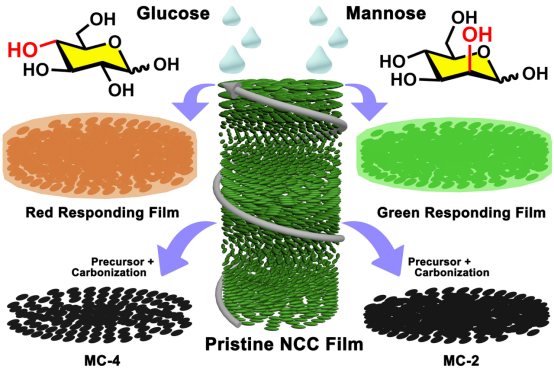Chemoselectivity of Pristine Cellulose Nanocrystal Films Driven by Carbohydrate−Carbohydrate Interactions
Fusheng Zhang, Dongdong Wang, Haijuan Qin, Liang Feng, Xinmiao Liang*, and Guangyan Qing*
ACS Applied Materials & Interfaces, 2019, 11, 13114-13122.
DOI: 10.1021/acsami.9b00471

Biological photonic nanostructures comprising hierarchically self-assembled cellulose nanocrystal (CNC) have been exploited for the development of sensing, optoelectronics, and energy materials. Although multiple techniques are used for controlling the optical response and chiral nematic structure of the CNC-derived materials, the presence of external studies that pristine CNC has chemoselectivity is not yet reported to implement this destination. Here, we report that CNC film without modification shows a high optical sensitivity for glucose through color variation from blue to red. Moreover, various glucose homologs or analogs that only differ in terms of the orientation of a hydroxyl group are selectively distinguished through the naked eye. The excellent chemoselectivity of CNC is attributed to carbohydrate–carbohydrate selective hydrogen bonding interactions. Close binding with glucose induces the rearrangement of a CNC chain and strengthens repulsive interaction, thus increasing the helical pitch of the chiral nematic structure of the CNC film and changing its macroscopic color. This CNC chemoselectivity presents an unprecedented control of chiral nematic mesoporous carbon through monosaccharide species. The results provides a simple but highly efficient method to tune the optical and structural properties of CNC nanomaterials and to apply them for practical biosensor, chiral separation, and energy applications.
原生纤维素纳米晶膜的化学选择性源于糖-糖相互作用
纤维素纳米晶(CNC)自组装的多层生物光子纳米结构已被用于传感、光电子和能源材料的开发。虽然已有多种技术用在CNC衍生材料光学响应和手性向列结构的调控,但目前还没有报道显示,原始CNC的化学选择性能实现这一目标。这里,我们报告了未经修饰的CNC膜对葡萄糖具有很高的光学灵敏度,正如从蓝色到红色的颜色变化。此外,不同的葡萄糖同系物或类似物(它们只存在着一个羟基方向上的不同)也可以在CNC膜上选择性地肉眼辨别。CNC具有这样卓越的化学选择性归咎于糖糖选择性的氢键相互作用。正如葡萄糖紧密结合诱导了CNC链的重排,增强了排斥相互作用,从而增加了CNC膜手性向相结构的螺距,改变了其宏观颜色。通过单糖种类差异,这种CNC的化学选择性还可实现手性向列介孔碳的结构控制。这些结果为调整CNC纳米材料的光学和结构特性提供了一种简单而高效的方法,势必将在实际的生物传感器、手性分离和能源中得到应用。